By this time of year many American Avocets have already paired up and some of them are beginning early nesting activities.
1/1600, f/8, ISO 500, Canon 7D Mark II, Canon EF 500mm f/4L IS II USM + EF 1.4 III Extender, not baited, set up or called in
I spent some time yesterday morning with this obviously bonded pair at Bear River Migratory Bird Refuge. Sexes are very similar but this photo shows their few differences – the male is larger and the female has a more strongly recurved bill.
1/1600, f/8, ISO 500, Canon 7D Mark II, Canon EF 500mm f/4L IS II USM + EF 1.4 III Extender, not baited, set up or called in
Both sexes share nest site selection duties and twice I saw the female squat down and wiggle her cute little fanny into the vegetation – she was obviously testing those spots for their suitability as a potential nest site.
1/4000, f/7.1, ISO 500, Canon 7D Mark II, Canon EF 500mm f/4L IS II USM + EF 1.4 III Extender, not baited, set up or called in
Toward the end of my time with them I caught the male in a wing lift. Photographing this behavior is troublesome for the photographer because usually we’re shooting horizontally (instead of vertically) and we have to remember that when their wings go up…
1/4000, f/7.1, ISO 500, Canon 7D Mark II, Canon EF 500mm f/4L IS II USM + EF 1.4 III Extender, not baited, set up or called in
the reflection of their wings goes down which requires a lot of vertical space to keep from clipping anything on the combined bird and reflection. Sadly I cut off the wings in the reflection in all six photos I took with the wings fully extended vertically.
Don’t even ask me why I didn’t just lower my lens a bit. Before cropping I had the room…
1/4000, f/7.1, ISO 500, Canon 7D Mark II, Canon EF 500mm f/4L IS II USM + EF 1.4 III Extender, not baited, set up or called in
So this was all I could salvage of the previous shot – a large crop that didn’t include most of the reflection.
1/3200, f/7.1, ISO 500, Canon 7D Mark II, Canon EF 500mm f/4L IS II USM + EF 1.4 III Extender, not baited, set up or called in
Wing lifts often (though not always) signal imminent takeoff so I was ready when it happened. This isn’t an ideal wing position but if they had been fully extended vertically I’d have clipped or cut off the wings again and I do prefer this over that.
Sometimes I remove dark spots (floaters) on the water surface with the clone tool but in this situation there were so many of them I chose not to.
- Note: This shot perplexes me a little. I typically use the reflection to level an image when the water’s relatively undisturbed – in this case I used the reflection of the eye and rotated until it was exactly vertical to the actual eye. But the water ripples around the legs tell me that the image still needs some counterclockwise rotation. In other words those two visual cues apparently don’t agree with each other. Occasionally that happens and I’m not sure why…
It was a delight to get back to Bear River again. The refuge has been closed for several weeks due to flooding but they were able to reopen a few days ago. With warm weather coming up snowmelt in the mountains is likely to cause them to shut down once again so locals had better get out there while they can.
I’ve never seen so much water in the wetlands approaching the refuge as I saw yesterday!
Ron


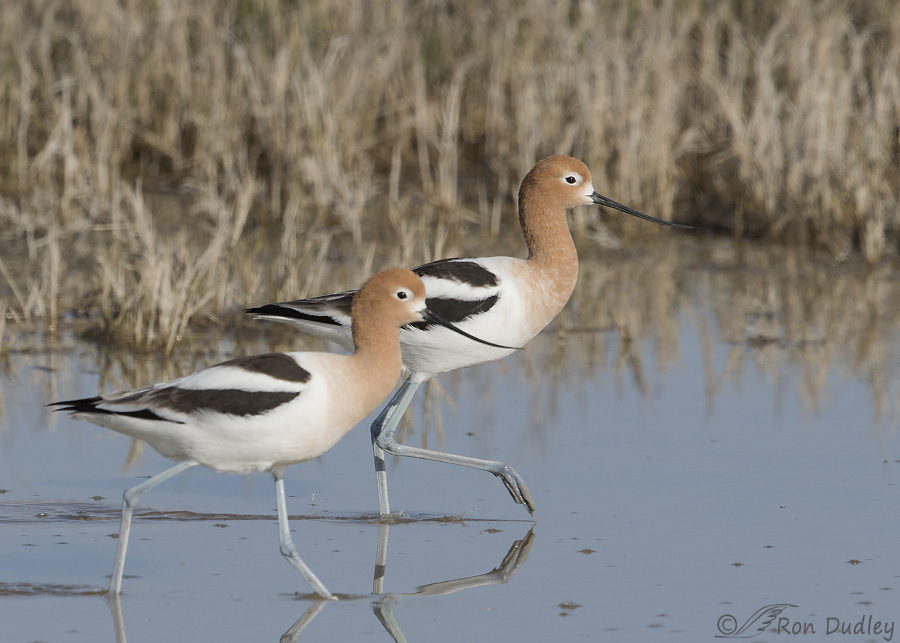
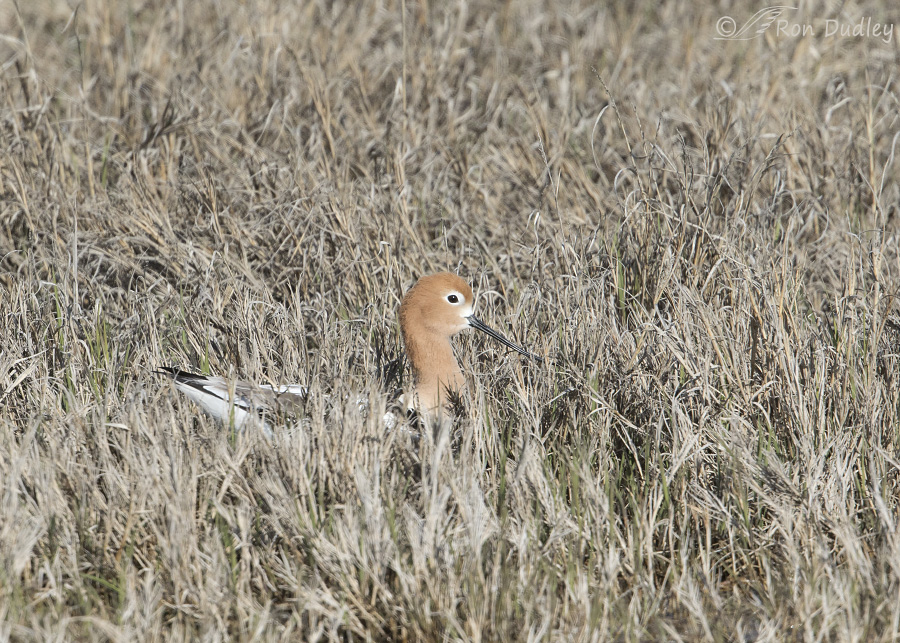
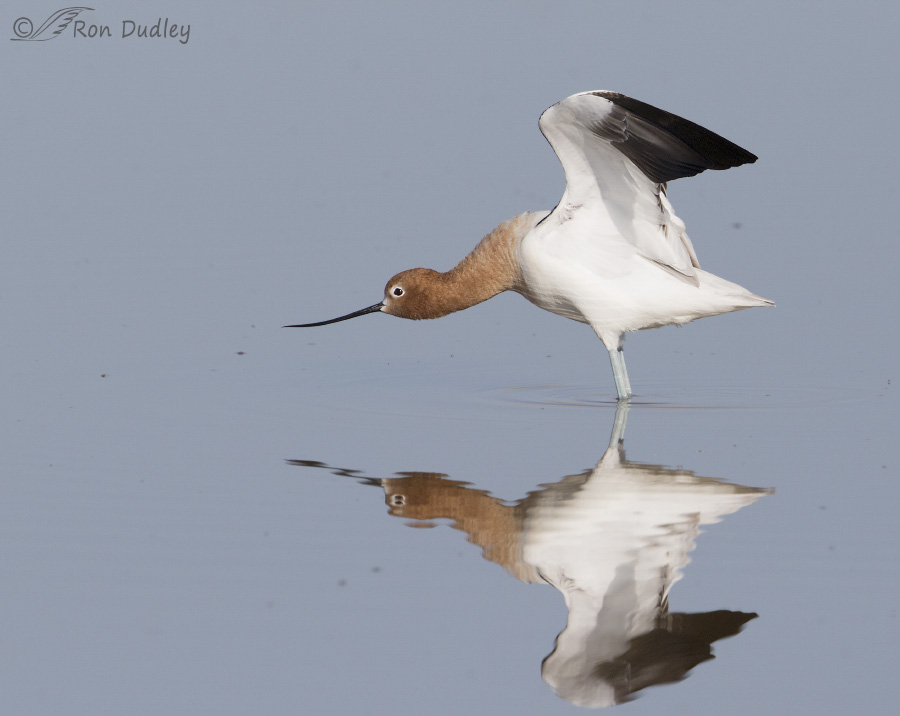
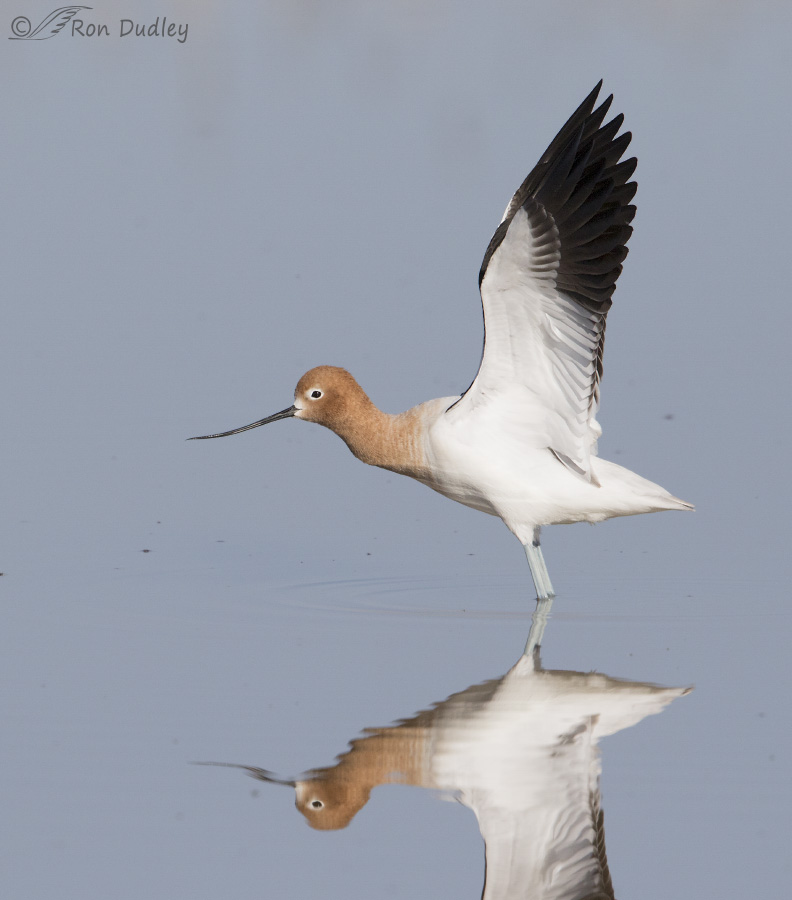
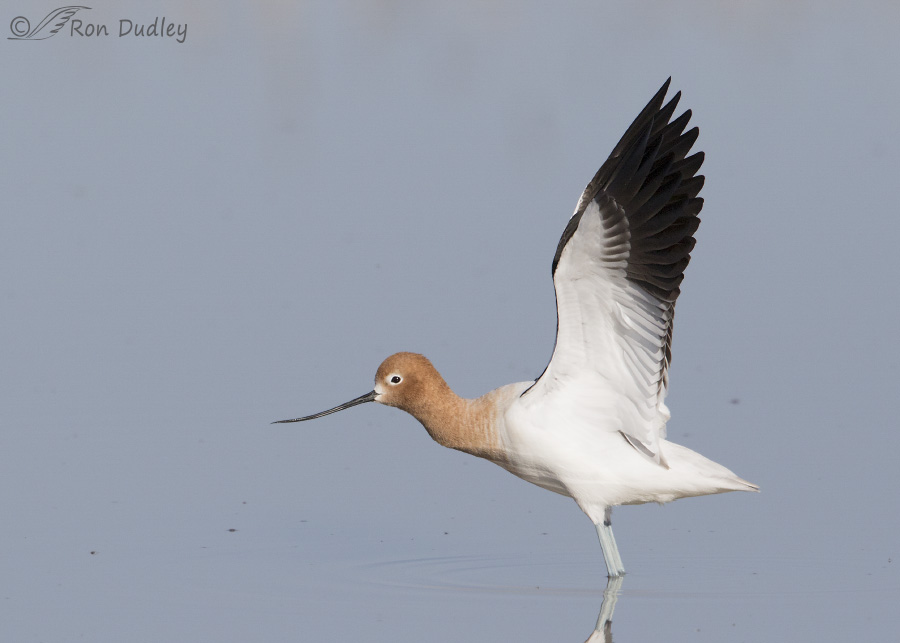
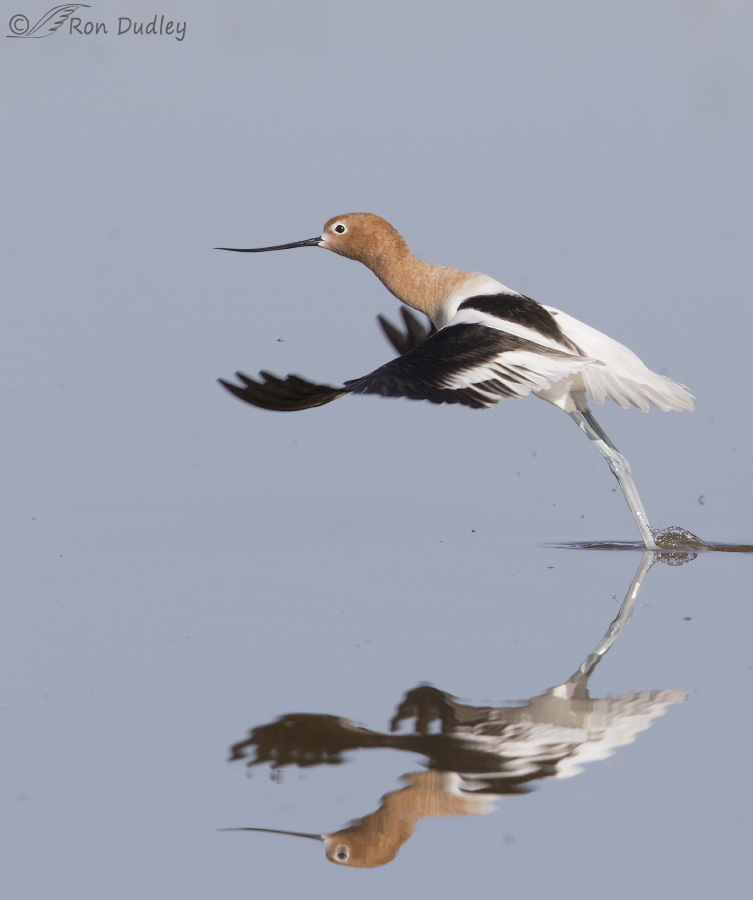
These avocets are such an elegant pair and I love that first image of them side by side — “obviously bonded” indeed. The differences are quite startling when they’re together like that. I hope they’ll have a successful breeding season — perhaps you’ll get some fledging photos later on! (A girl can dream ….)
Ron,
Beautiful. I was up there today and it really was a treat to see so many birds back and recognize so many more of them than I have in the past. I give you, your posts and your numerous pictures & explanations credit for that. Thanks for your skills and efforts. I enjoy your posts every day.
Stephen
great photos it is like you are in some exotio foreign land…nope just the states…thanks
Beautiful photographs! Such graceful birds. Thanks for sharing them as well as all photography info.
Thanks, Joanne. Always nice to know that folks appreciate the image techs because they’re a lot of extra work to include.
Gorgeous pictures. They are so elegant looking. Similar to a Swan in my book. I didn’t realize the female’s beak curved more then the male. I learned something today!
Thanks, Jean. It’s always a good day when we learn something!
The first and the last have my vote today.
Love the reflection in the first – It almost looks as if there is a leg and foot emerging from the water, as well as descending.
I am very glad you could get back to Bear River. It must feel like going home.
“I am very glad you could get back to Bear River. It must feel like going home”
It certainly does, EC. I’ve been going there since the 70’s and some of my early trips were with Terry Tempest Williams and other good friends from our days at the Utah Museum of Natural History. So I have lots of wonderful memories from the refuge. Besides I love that place just for what it is…
Incredible shots of beautiful birds. As much as I like the wing lift and takeoff shots, the first shot us my favorite. It puts in mind the Beatles’ song “Happy Together” (and yes, I gave that earworm, so I thought I’d share). This us a very special series.
Now my iPad is doing it — those two us-es should be is-es! And gave should be have. I usually catch these before I hit Post Comment. I think autocorrect is trying to mess with me!
It hates you…computers, iPads, tablets hate humsns…
And to think that I only included that image as an afterthought, Marty. At first I wasn’t going to mention breeding/mating behavior so that image almost didn’t happen on this post. Thank you.
Patty (or her iPad) is contagious…
Watch it!!! It’s the iPad–NOT me!!!
Our iPads must be communicating off-line. Spooky! (I’m typing this on my laptop, just for safety’s sake!)
(I’m typing this on my laptop, just for safety’s sake!) 
I like your photos for a lot of reasons and one of them is very well showed on the first photo of today’s series. They are “alive”,they show emotions.
See that couple of Avocets. It looks like they are so proud, so happy to be together.
Very well done.
On a side note I think that sometimes a zoom lens can be very handy…
I agree strongly with both of your observations, Jorge. And yes, these two birds seemed delighted to be in each other’s company. Once another mated avocet pair flew in and landed perhaps 25 yards away from them and these two relentlessly hounded them until the intruders flew off. They made quite the team.
And yes, in some situations the flexibility of the zoom is essential for the best results possible.
Thank you for your excellent observations.
Ron: What great shots! Especially the wing lift – the bird can be so graceful. Love seeing the Avocets in full breeding plumage. And the male-female comparison was a great lesson. Thanks!
Agreed about their gracefulness, Richard. And I think that beautiful recurved bill only adds to it.
Beautiful shots, It obviously was a delight for you!
Man, this brings back memories of North Dakota when we were temporarily put in charge of taking care of Lostwood National Wildlife Refuge during a 4th of July weekend so the staff could take a break. That trip was a highlight. Birded all around that area in 1972! Probably a lot has changed since!
Thanks for sharing these great shots.
Sounds like you had a blast in ND, Dick. Good memories for you!
Thanks for a wonderful series…the last is definitely the Grand Finale…love the reaching take off position, the teflection and the disturbed water…BEAUTIFUL bird !!!
Patty, I was happy to get that last shot too. For their size avocets are very quick birds at takeoff.
Love these photos!
Thank you, Elmer.
Good morning Ron. Love you Avocets. One of my favorites along with Black Necked Stilts and thanks for the tip about the bill difference in the sexes. I did not know that. I am no expert in the physics of light and I could be completely out to lunch, as my wife often relishes in tell me, but perhaps what you are observing is due to the fact that the bird is, just slightly, facing away from you. I have been trying to visualize this in my mind for the last 10 minutes for verification, but for some reason I can’t get there, but I will stick with my theory for now.
Thanks, Frank. Personally I can’t see how the bird facing away from me would make the difference but then I’m not a physicist either…
Wonderful “eye candy” Ron. Water and light can do strange things when combined in reflections making what was “horizontal” questionable:) Belt Creek gets me on that regularly. All are wonderful shots, but the wings in the last photo REALLY catch my eye.:) Glad all the water is around – some of our “prairie potholes” have more than they’ve had in awhile at present.
Water and light can do strange things when combined in reflections making what was “horizontal” questionable:) Belt Creek gets me on that regularly. All are wonderful shots, but the wings in the last photo REALLY catch my eye.:) Glad all the water is around – some of our “prairie potholes” have more than they’ve had in awhile at present.
I remember those prairie potholes up west of Cut Bank, Judy. They’d often be teeming with birds in the spring.
Spectacular series,Ron! I would have been thrilled with just one Avocet photo this morning!
Agreed, Diane – avocets are always a treat, especially in their breeding plumage. Thank you.
Marvelous shots and interesting info Ron! Thanks for sharing!
charlotte
Thank you, Charlotte.